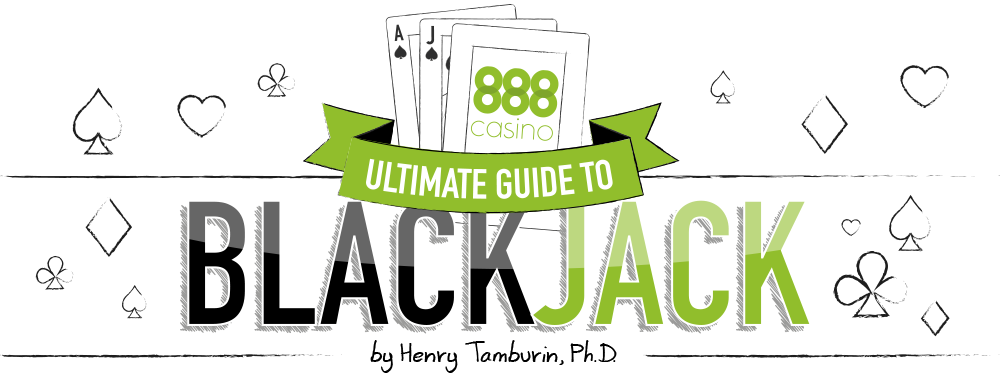
BLACKJACK VARIANTS

There are several variants of the traditional blackjack game that you will find being offered in land-based and online casinos. In this chapter, I’ll explain four of them: Spanish 21, Free Bet Blackjack, Blackjack Switch, and Super Fun 21.
SPANISH 21
One of the more popular blackjack variant is Spanish 21. In this chapter, you’ll learn how to play this game, what makes it unique, and how it’s possible to gain the edge when you play. Before we will start, if you still need to learn how to play blackjack, go to the first chapter of this guide.

PLAYING RULES
Instead of the usual 52 cards per deck, the game is played with a 48-card Spanish deck: a standard 52-card deck with the four 10s removed. Playing blackjack without the player friendly 10s is not good for players (the house edge zooms to roughly 2 percent). However, to compensate for the removal of the 10s, the playing rules for Spanish 21 are much more liberal than for a traditional blackjack game. For example, if you get 21, you always win even if the dealer has 21; you can surrender anytime, even after doubling, pair splitting, and hitting; and some hands, such as a five-, six-, and seven-card 21, pay a bonus.
The table below summarizes the typical Spanish 21 playing rules and compares them to the traditional game of blackjack.
(Note: There may be some slight differences in rules from one casino to another.)
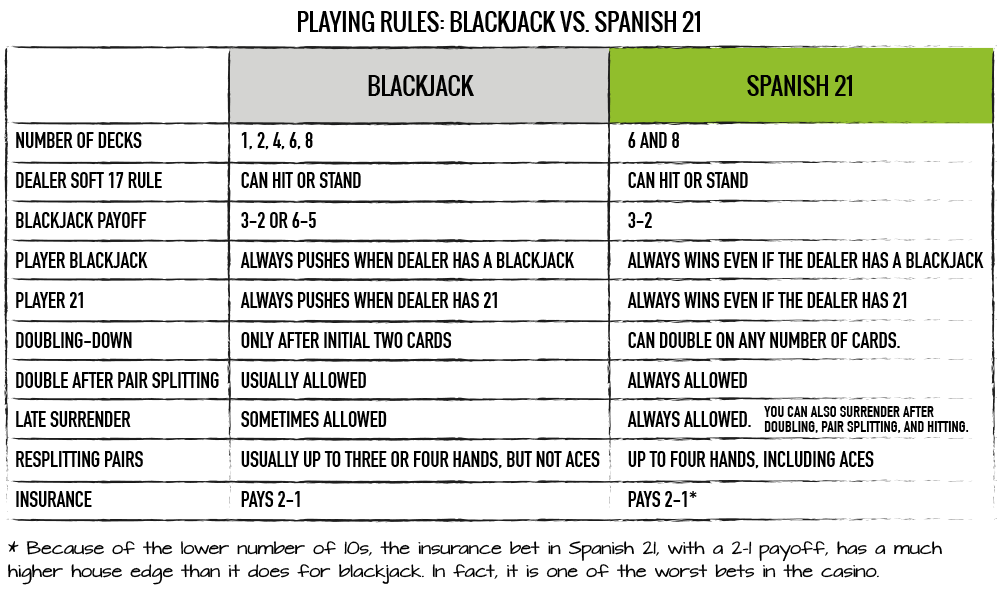

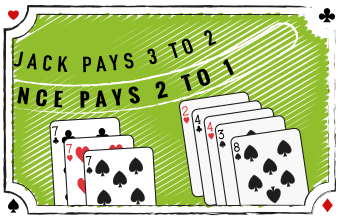
BONUS HANDS
Another difference with Spanish 21 compared to blackjack is bonus hands. Spanish 21 often pays a bonus for five-, six-, and seven-card hands that total 2, and 6-7-8 plus 7-7-7 hands. The payoffs for these bonus hands vary but they are all greater than even money.

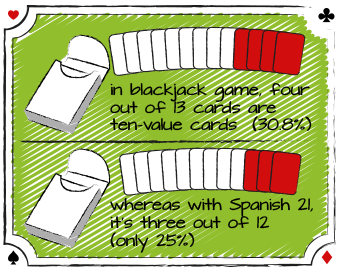
EFFECT OF THE MISSING TENS
If you’re getting excited about playing Spanish 21 because of all of these great rules and bonus hands, listen up: All those great rules don’t come close to making up for all those missing tens. Furthermore, if you play it like you play a traditional blackjack game, you will get hammered. Why? Because with all the pip 10s removed (i.e., actual 10 of diamonds, hearts, spades, and clubs), the ratio of low cards to high cards in Spanish 21 differs from blackjack. Normally, four out of 13 cards in blackjack are 10-value cards (30.8 percent). In Spanish 21, this ratio is reduced to three out of 12 (only 25 percent). The bottom line: these major differences in rules have a great effect on the playing strategy, meaning the playing strategy for Spanish 21 is different and slightly more complicated than it is for blackjack.
Here’s a concrete example: If you have a stiff 12 through 16 in blackjack and the dealer shows a 2–6, you simply stand (except you would hit 12 against dealer’s 2 and 3). With Spanish 21, hitting becomes more attractive because you have less chance of busting (remember, there are fewer 10-value cards), and if you hit to 21, you automatically win. Therefore, some of the traditional “stand on stiffs” becomes “hits” in Spanish 21, when your stiff hand contains four, five, or six cards. So, whereas the traditional basic blackjack strategy tells you to stand (or double) regardless of the number of cards in your hand, in Spanish 21, the number of cards in your hand can influence whether you play a hand one way or another.

Here’s another example. Suppose you are dealt a 14 against a dealer’s 4. In blackjack, you stand (designated “S” in our blackjack strategy tables). In Spanish 21, you stand, except if your 14 consists of four or more cards (designated “S4” in the strategy table), in which case, you would hit. So, if you were to look at the complete basic strategy table for Spanish 21, it would contain not only the familiar H, D, and S’s but also S4, S5, S6, and D3, D4, and D5 to designate the exceptions in playing strategy (either standing or doubling) based on the number of cards in the hand.
If you’re beginning to think the basic strategy for Spanish 21 is more complicated than it is for blackjack, you’re right. But it’s not something you can’t master; it just takes a little more time to learn, compared to blackjack’s basic strategy. You’ll find accurate basic- strategy tables for h17 and s17 from several sources:
- The Big Book of Blackjack by Arnold Snyder has a simplified basic strategy for Spanish 21
- The Spanish 21 page on the wizardofodds site
- The Pro’s Guide to Spanish 21 and Australian Pontoon by Katrina Walker

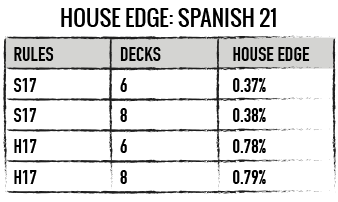
HOUSE EDGE
For a six-deck, s17 game, the house edge (as a percentage of initial wager) using the Spanish 21 basic playing strategy (U.S. standard rules) is only 0.37 percent (from Katrina Walker’s book). As you can see, a Spanish 21 game with s17 is much more player friendly than one with h17; however, to achieve these low house edges, you must learn the Spanish 21 basic playing strategy.

REDOUBLE OPTION
The redouble option is available in some land-based casinos, especially in the state of Washington. This player-friendly option allows a player to double down again after doubling and getting a card. For example, if you were to double down with a 6-3 and drew a 2 for an 11, you could double down again.
(Note: Demonstrate the redouble option with cards on a layout. Player has 6-3-2 with dealer queen showing.)
With redoubling allowed, the house edge decreases slightly (For example, from 0.78% in h17, six-deck game to 0.42%). However, keep in mind that the redouble option makes the basic playing strategy for Spanish 21 even more difficult.

PONTOON
Spanish 21 is known as “Pontoon” in Australia. The rules are similar to Spanish 21, with these notable exceptions: The dealer does not receive a hole card, you can redouble up to three times, and the Ace in pre-doubled hands counts only as one (instead of one and 11). For more information on Pontoon, consult Katrina Walker’s book.

CARD COUNTING
Card counting will give you a slight edge for Spanish 21 but the bet spreads are wider and the risk of being suspected as a card counter greater. There are two good sources books that contain card counting systems for Spanish 21:
- The Big Red Book of Blackjack (using the Red 7 counting system)
- The Pro’s Guide to Spanish 21 and Australian Pontoon (using the Hi-Lo counting system)

SUMMARY
Even though Spanish 21 is offered in many land-based and online casinos, I wouldn’t recommend you spend the extra time learning a more difficult basic playing strategy if traditional blackjack games with good rules are also available wherever you play. However, there are opportunities with Spanish 21 if it happens to be the best game you can find. Just be sure you learn and use the basic strategy for Spanish 21, along with a counting system.

KEY TAKEAWAYS
- Spanish 21 is played with a deck of cards with all the pip tens removed
- The removal of the tens increases the house edge roughly 2%. To compensate for this, the playing rules for Spanish 21 are very liberal
- The basic playing strategy for Spanish 21 is slightly more complex than the traditional basic playing strategy
- Even with the addition of the liberal playing rules, the house edge ranges from 0.37% to 0.78% (rule dependent) when using the Spanish 21 basic strategy
- The redouble option, available in some casinos, is very player favorable (although it complicates the playing strategy slightly)
- There are card counting systems that can give the player an edge at Spanish 21
- Never play Spanish 21 using the traditional basic playing strategy; always use the Spanish 21 basic playing strategy.

BLACKJACK SWITCH
Suppose you’re playing blackjack, you hold a King-6, and the player next to you has 4-Ace. Wouldn't it be nice if you could switch your 6 with his Ace so you would have a blackjack? Of course, you wouldn’t try to switch these cards in a casino because if you were caught you would be in a heap of trouble (switching cards is a cheating maneuver). However, the blackjack variant known as Blackjack Switch legally allows you to switch your cards between two hands. (The game is offered in land-based and online casinos.)

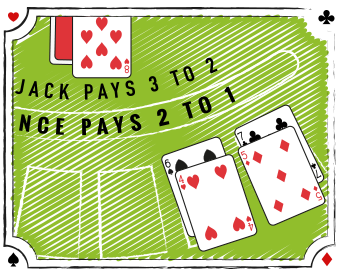
PLAYING RULES
With Blackjack Switch, you must play two hands with equal bets per round and you have the choice of keeping the hands that you were dealt or switching the second card in each hand. This switching option gives players a big advantage because you could convert one or two bad hands into two very good hands.
Here's an example of what I mean.
Suppose you received these two initial hands:
PLAYER’S INITIAL TWO HANDS
Hand #1: 7 of clubs and 5 of diamonds
Hand #2: 6 of spades and 4 of hearts
The dealer has an 8 upcard.
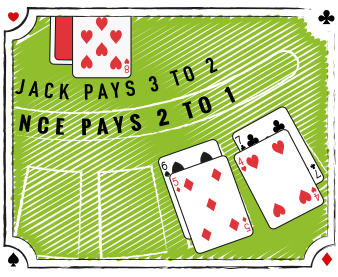
You have a decent play on the second 6-4 hand, namely, to double down against the dealer's 8. However, the other hand (a 12 against the dealer’s 8) is a loser. However, by switching the second card of each hand (the 5 and 4), you would wind up with two powerful hands (7-4 and 6-5), and you could double both against the dealer’s 8. In this example, switching the second cards is, clearly, the preferred strategy.
AFTER SWITCHING
Hand #1: 7 of clubs and 4 of hearts
Hand #2: 6 of spades and 5 of diamonds
The dealer has an 8 upcard.

THE CATCH
To offset the player-favorable switching option, in the rules for Blackjack Switch there are two catches, namely:
1. When the dealer’s hand totals 22, all players’ hands push (except a player’s blackjack); and
2. All player blackjacks pay even money (instead of 3-2).
For example, suppose you double down on 10 and catch an ace for a 21. The dealer proceeds to hit his 16 and catches a 6 for 22. Your 21 is a push.
The other playing rules for Blackjack Switch follow the conventional rules for the game. Six (and sometimes eight) decks of cards are used, the dealer usually hits soft 17, and you can double down on any two cards and after pair splitting. I’ve summarized the complete playing rules for Blackjack Switch as played in a Las Vegas casino below. (Note: Online and land-based casinos can change the rules at any time.
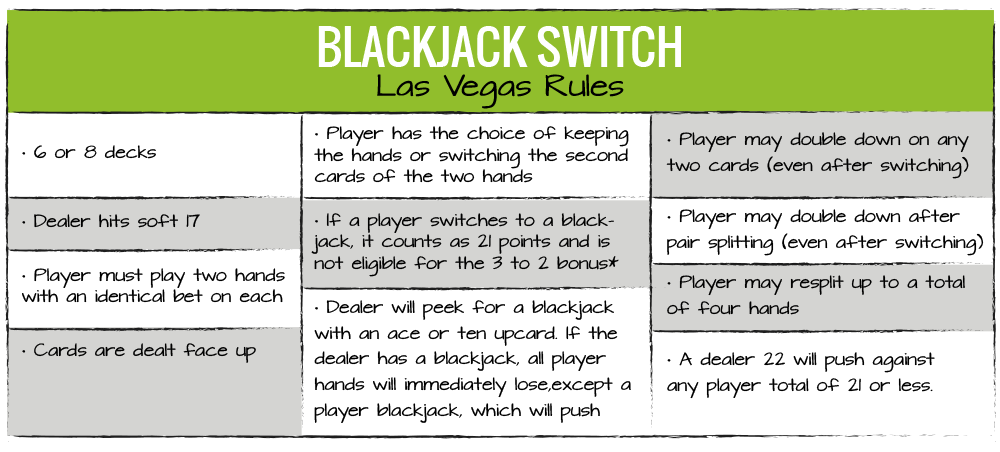
* In some casinos, a switched blackjack will automatically be paid even money. In other casinos, a switched blackjack will not be paid until after the dealer completes her hand, and if she has a 21 or 22, the switched blackjack is a push. (The former rule is much more player favorable.)

PLAYING STRATEGY
As you would expect, the basic playing strategy for Blackjack Switch is slightly different from the conventional basic playing strategy because of the dealer 22 push rule. For example, you will be doubling and splitting less often, and there will be more hands where it is correct to hit at the risk of breaking.
Here are some sample hands that show the differences in strategy.

You can obtain the complete basic playing strategy for Blackjack Switch on these sites: www.blackjackforumonline.com, www.wizardofodds.com, and www.discountgambling.net.
There is also a playing strategy for this game in the book The Big Book of Blackjack.
What you need to remember is that you shouldn't use the conventional basic strategy when you play this game; instead, you need to follow the basic strategy that is specific to Blackjack Switch. It's not any more complicated, just slightly different.

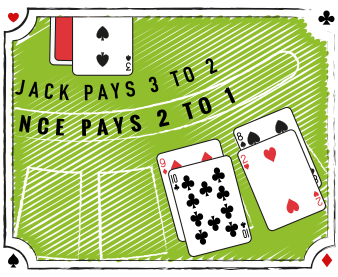
SWITCHING STRATEGY
The more difficult strategy to master is the switching decisions because sometimes the decision to switch is not obvious. For example, would you switch the second card in each of these hands?
Hand #1: 8 of spades and 2 of hearts
Hand #2: 9 of diamonds and 10 of clubs.
Dealer’s upcard is a 3.
If you switch the second card in each hand, you would have these hands:
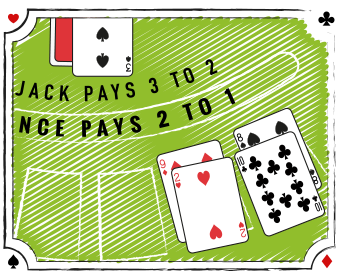
Hand #1: 8 of spades and 10 of clubs
Hand #2: 9 of diamonds and 2 of hearts
Dealer’s upcard is a 3.
The question facing you is this: is it better to keep the initial 10 and 19 against the dealer's 3, or switch and play the 11 and 18 hands? Would you switch?
The best strategy is to keep the original hands (10 and 19) and not switch. How do I know? You have to become familiar with the switching strategies.
The best source to obtain the switching strategy is the above book or the above two web sites.

HOUSE EDGE
According to wizardofodds, the house edge for the Las Vegas game where a switched blackjack automatically wins is 0.18% for the six-deck, h17 game (it’s 0.20% if eight decks are used). If a switched blackjack pushes against a dealer 21 or 22, the house edge is 0.58% (6 decks) and 0.60% (8 decks). Remember that you can achieve these house edges only if you master the basic playing and switching strategies for this game.
WHICH LAND-BASED CASINOS OFFER BLACKJACK SWITCH?
You can find a list of U.S. casinos that offer Blackjack Switch at www.blackjackswitch.com. Many more casinos are planning to offer this game. Check with your local casino if they plan to offer it and when.
PRACTICE PLAYING
You can practice playing Blackjack Switch on your computer. Go to www.blackjackswitch.com and click on “Download” to download the game to your computer. You can play for fun, get a feel for how the game plays, and practice your switching strategy. You’ll also find a “switching calculator” for a specific set of rules on wizardofodds (Blackjack Switch page).

KEY TAKEAWAYS
- You must play two hands and wager the same on each hand
- You have the option of switching the second card in each hand
- When the dealer has 22, all players’ hands push (except a blackjack) and a player’s blackjack pays even money
- There is a basic playing strategy and switching strategy for this game that should be learned
- The switching strategy is relatively complex
- The house edge can be reduced to about 0.5% (rule dependent) using the switching strategy and post-switching basic strategy

FREE BET BLACKJACK
Have you ever wished the dealer would pay you to match your double down and pair splits? That’s exactly the twist in this new game called Free Bet Blackjack (invented by Geoff Hall, the creator of Blackjack Switch)), and it is available in land-based and online casinos.

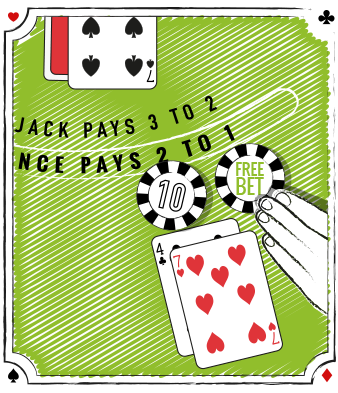
PLAYING RULES
This game is available with single-, double-, six-, and eight-deck games. Rules vary but the most popular version has these rules: Six-deck, h17, das, resplits up to four hands, including aces, no surrender, and a blackjack pays 3-2. The twist in the rules, compared to a traditional blackjack game, is Free Doubles and Free Splits.
They work as follows:
- Free Doubles means on hard totals of 9, 10, and 11, the player’s original wager is matched with a “free bet” token, and the player receives one draw card to complete the hand.
- If the dealer wins, the player loses only his original bet
- If the hand pushes (or ties), the player will get back his original bet
- If the player’s hand beats the dealer’s hand, the player is paid for his original wager plus an amount equal to the original bet
For example, if your original wager was, say, $10 and you doubled on a hard 11, with the “Free Double” you win $20 if your hand beats the dealer’s hand. With the Free Double, you risked $10 on the hand with the opportunity to win $20.
Note: Free Doubles are not in effect for any hand that contains an ace (meaning any soft hand, like A-6). You can still double down on a soft hand only you don’t get the Free Double.
- Free Splits means your original pair is separated into two hands, the original wager is placed on the first hand, and the free bet token is placed on the second hand. (Note: Free Splits is not available on 10s). You play each hand one at a time. If in the course of playing out either hand, you can double down or resplit (up to four hands), each resplit and double is allowed a Free Bet. Every time a hand wins, the “free bet token” is paid with real casino chips (and the token is removed by the dealer). Similarly, if a player loses or pushes, the free bet token is removed by the dealer.
With free bets available to resplits and double downs after splitting, it’s possible (although slim) that a player could end up with a total of eight bets while only paying for one of them (the other seven would be free).
Note: Players can split and double on all other hands that don’t qualify for a “free bet” using regular casino chips (as you would in a traditional blackjack game.)

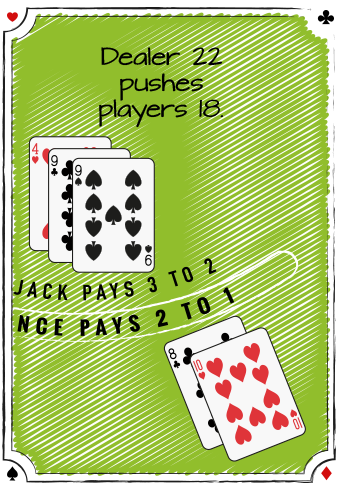
THE CATCH
If just Free Doubles and Free Splits were allowed in a traditional six-deck blackjack game, a player would have about a 6% advantage. Therefore, to compensate for the Free Doubles and Splits, there is a “Push 22” rule which is:
- A dealer’s “bust” hand of 22 will push (or tie) all unbusted player hands rather than paying them. (Except an untied player’s blackjack is paid at 3 to 2.)
PLAYING STRATEGY
One strategy you should invoke is to always accept all free splits and doubles even if some seem counter-intuitive (like doubling 9 against a dealer’s ace). There are some other basic strategy changes due to the Push 22 rule and you can find a published basic strategy for Free Bet Blackjack on www.wizardofodds.com and www.discountgambling.net.
HOUSE EDGE
The house edge for an h17 game is about 1% (assumes you accept all Free Doubles and Splits, and you use the Free Bet Blackjack basic playing strategy).

KEY TAKEAWAYS
- Free Bet Blackjack allows players free doubles and splits
- When the dealer has a 22, all unbusted player hands push
- You should always take the Free Doubles and Splits
- The basic playing strategy is slightly different than the traditional basic strategy because of the Push 22 rule
- The house edge is about 1% (rule dependent)

SUPER FUN 21
Super Fun 21 is another variant of blackjack that was invented by none other than card counter Howard Grossman. (I knew Howard from my playing days in Atlantic City.) The game offers plenty of liberal player rules, which is the attraction of the game.

PLAYING RULES
The playing rules are:
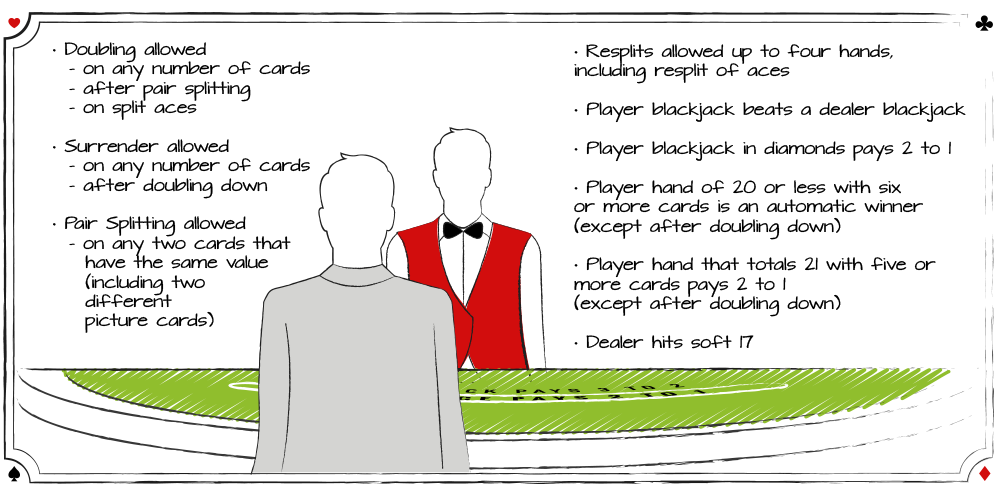
You’ll find Super Fun 21 played mostly with a single-deck of cards (another appeal to players), although double- and multi-deck versions are offered in some casinos.
You might be thinking that with all these liberal rules, this game must be good to play. There is a catch, however.

THE CATCH
The casino neutralizes all of the above liberal rules with one caveat:
- Player blackjacks pay only even money (except if the player has a diamond suited blackjack where it pays 2 to 1).
The net result is about a 1% house edge against a basic strategy (rule dependent).

BASIC PLAYING STRATEGY
Fortunately, the basic playing strategy for Super Fun 21 is very similar to the basic playing strategy for a traditional blackjack game but there are some adjustments that need to be made. For example, in a single-deck game you always double down with hard 10 (and 11) no matter what the dealer’s upcard is; you split 9s against a dealer ace; and you surrender 7s against a dealer’s upcard of 10 and Ace. You can find the complete playing strategy for Super Fun 21 in The Big Book of Blackjack and at wizardofodds. Be sure to learn the basic strategy for this game if you decide to play it in a land-based or online casino.
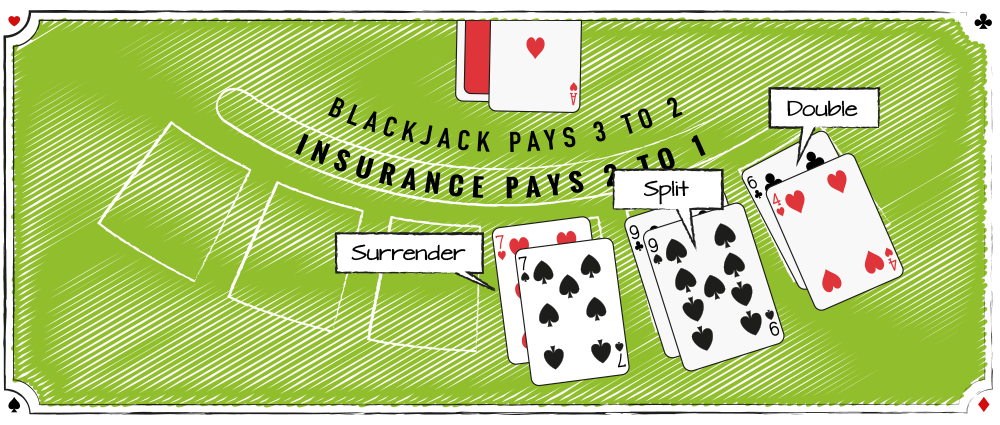
CARD COUNTING
This game can be beaten by card counting but it takes a very aggressive bet spread (at least 1 to 10). You’ll find a published Red Seven counting strategy for Super Fun 21 in The Big Book of Blackjack.

KEY TAKEAWAYS
- Super Fun 21 has a host of liberal playing rules
- The catch is a player blackjack pays only even money (except blackjack in diamonds pays 2 to 1)
- The basic playing strategy is close to the traditional basic playing strategy but there are some adjustments to the strategy that need to be learned
- The house edge is about 1%
- You can get the edge by card counting but you must use a very aggressive betting sprea

STADIUM BLACKJACK
Stadium Blackjack is a new way to play blackjack that consists of up to 44 electronic player terminals spread out in a stadium-configured arrangement. Each active player places a wager on their own player terminal, and the results of the game are determined by a live dealer utilizing community cards to reconcile player decisions.What makes Stadium Blackjack unique is that all the active players start with the same starting hand against the same dealer’s up card, yet, because of the way the community cards are distributed to complete the players’ and dealer’s hands based on the playing decisions made by each player, at the end of a round each player could have a different final hand against a different final dealer’s hand and a different outcome.
The playing rules are configurable by the casino; some only pay 6 to 5 for a player blackjack while others pay 3 to 2. The betting limits are usually lower than they are on the traditional blackjack games in a casino.

